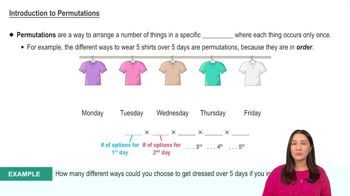Here are the essential concepts you must grasp in order to answer the question correctly.
Permutations
Permutations refer to the different ways of arranging a set of items where the order matters. The notation nPr represents the number of ways to choose r items from a total of n items, considering the arrangement. This concept is crucial for understanding how to calculate the number of possible arrangements in various scenarios.
Recommended video:
Introduction to Permutations
Factorial
The factorial of a non-negative integer n, denoted as n!, is the product of all positive integers up to n. Factorials are fundamental in permutations and combinations, as they provide the basis for calculating the total arrangements of items. For example, 5! = 5 × 4 × 3 × 2 × 1 = 120.
Recommended video:
Formula for nPr
The formula for nPr is given by nPr = n! / (n - r)!, where n is the total number of items and r is the number of items to arrange. This formula allows us to compute the number of permutations efficiently by utilizing factorials. In the case of 6P6, it simplifies to 6! / (6 - 6)! = 6! / 0! = 720, since 0! is defined as 1.
Recommended video:
Solving Quadratic Equations Using The Quadratic Formula
 Verified step by step guidance
Verified step by step guidance Verified video answer for a similar problem:
Verified video answer for a similar problem:



 4:4m
4:4m